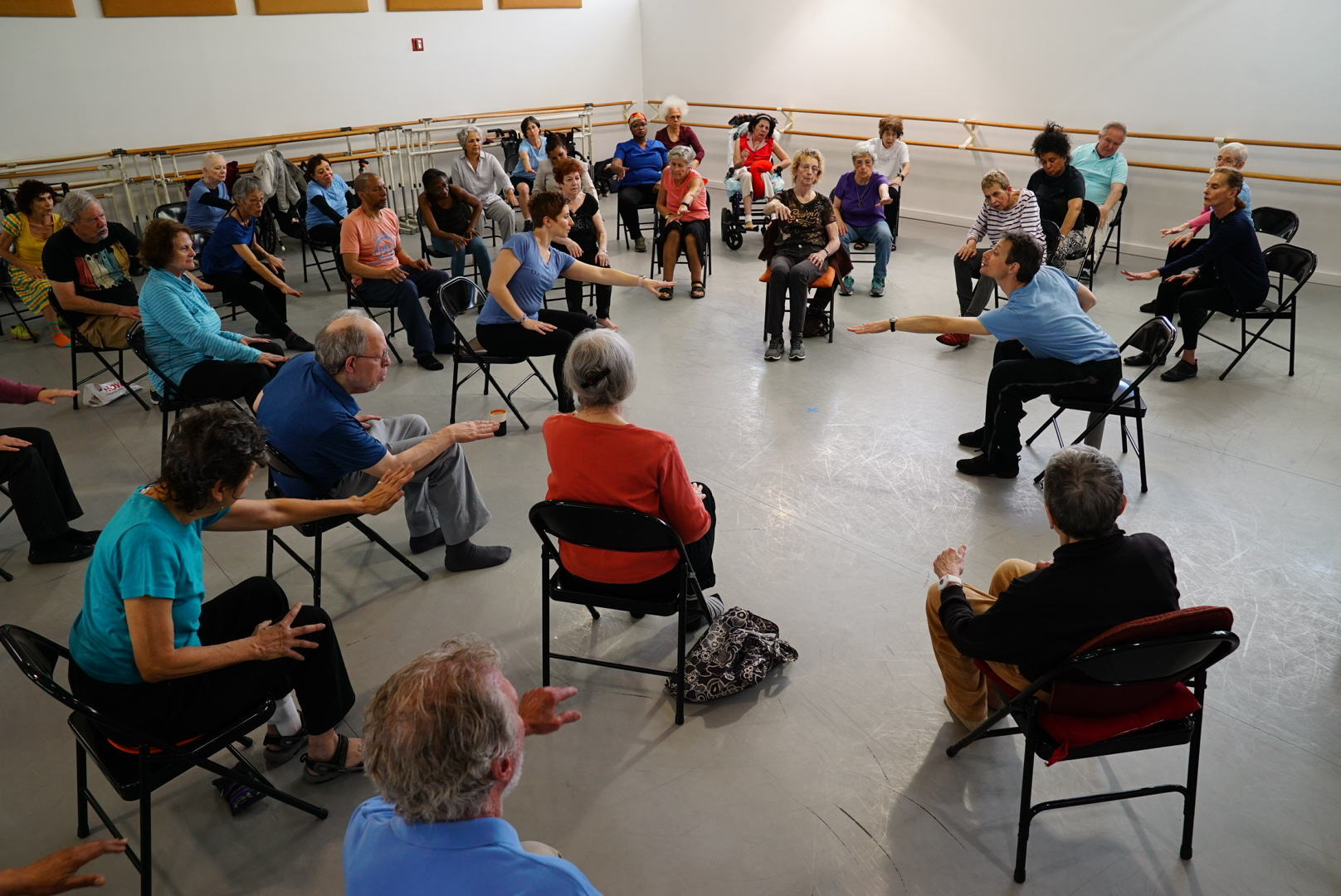
David Leventhal was a member of the Mark Morris Dance Group (MMDG) from 1997–2010, appearing in more than 40 works. He performed principal roles in The Hard Nut, L’Allegro, il Penseroso ed il Moderato, and Prokofiev’s Romeo and Juliet, on Motifs of Shakespeare.

In 2001, Leventhal became one of the founding teachers of MMDG’s Dance for PD program, offering weekly classes for people with Parkinson’s disease and their loved ones. The classes began in MMDG’s Brooklyn studio and are now offered in more than 300 communities in 28 countries. In addition to in-person classes around the world, Dance for PD® offers online classes via Zoom and on-demand, at-home videos on DanceforParkinsons.org. In 2016, Leventhal received a World Parkinson Congress Award for Distinguished Contribution to the Parkinson Community.
Nearly one million people in the U.S. are living with Parkinson’s disease (PD), the second-most common neurodegenerative disease after Alzheimer’s, according to the Parkinson’s Foundation. The disease can cause tremors, slowness, rigidity, and gait and balance problems. Dance for PD teaching artists integrate selected movements from a variety of dance styles, such as modern and theater, ballet, Afro-Caribbean, Latin, tap, and improvisation, to address PD-specific concerns like flexibility, coordination, social isolation, and depression.
Dance Teacher chatted with Leventhal to learn more about the Dance for PD program, the impact it has had on participants, and what the broader dance industry can learn from its success.
How was the Dance for PD program developed?
In 2001, MMDG opened a new building in Brooklyn. One of the people who came through our doors was Olie Westheimer. She was running a support group for people with PD called the Brooklyn Parkinson Group (BPG) and was thinking about ways to engage her community in activities that weren’t just focused on PD. Since she had a dance background and read an article about our new studio, she shared her idea with us. We were very enthusiastic, but we had no experience working with the PD community. MMDG worked closely with Olie and BPG to develop the class curriculum. Over time, the model started to take root in other cities that MMDG performed in, since we are a touring company. As more people experienced Dance for PD, they asked about ongoing classes for their communities. That’s when we developed a training program for dance teachers to take the approach back to their local area.
What has been your favorite part about teaching Dance for PD?
I get great satisfaction from witnessing people living with PD experiencing the kind of freedom, expression, and joyful exuberance that comes from dancing. PD is a really challenging condition that subtracts things from your life; things you used to be able to do, social networks you used to have, certain skills you used to rely on. Dance is able to reinvigorate people’s sense of themselves, of their bodies, and give them possibilities of what they still can do. I get to witness that during every class I teach. The physical effects last for a few hours, but I think the emotional effects last for a long time after that.
Another part of the program I really enjoy is building partnerships and collaborating between arts organizations, the PD community, and medical professionals, many of whom don’t have a lot of experience in dance or the arts. Once they see how people with PD respond to this activity, they become very enthusiastic and include it in their referral process. I would say 60 to 70 percent of people who come to our New York classes are there because their doctor recommended the program to them.
Have you had a role model in your teaching career?
Marjorie Mussman, who danced with the Joffrey Ballet for many years and taught all around New York. What Marjorie was good at was taking rather technical concepts and describing them like an everyday activity. She often used really strong imagery which made the movement accessible. That’s one aspect that I’ve really brought to Dance for PD. Oftentimes, a lot of our students are coming into a dance studio for the very first time. We really want to make that experience accessible for them, particularly if we are doing things that are drawing from a particular style or technique. So we do that through imagery and metaphors.

What is your one unique thing that you like to include in your classes?
We end class by all holding hands in a circle. You gently squeeze the hand of the person on one side of you and give a bow and then the next person will do it. That gets passed all around the circle. I did this in my first class in 2001 and I do it in every single class I teach. It is a very special moment for everyone because it recognizes the power and value of dancing together and being part of a community; the reliance we have on each other to be present and support one other. In ballet terms, you might call it a révérence. It’s révérence of gratitude for each other. If we have lost a member recently, we tend to honor them with that activity and a piece of music that may have been their favorite piece or something they liked to listen to.
Nowadays, the dance industry is really trying to be more accessible to a wider audience. The success of Dance for PD proves that it’s possible. What would your advice be for dance teachers and institutions on how they can build bridges in their community?
Every studio should be a community center. It should be a place where dance is shared generously. We all work hard to do that, but there are a lot of people who are missing from the studio. [So we should ask], “Who is in the community that isn’t here, and why aren’t they here? What is it about what we are offering that is not accessible yet to them, and how can we make it accessible? Is it barriers related to culture, language, or socioeconomic background?” For instance, if you only offer classes midday on Wednesday, maybe there are a lot of folks who are working [that can’t make it]. Dance for PD offers classes in Spanish and Mandarin, and our teachers reflect many diverse cultures, so no one is left out. Everyone has a right to enjoy the benefits of dance, but dance can be a scary word for people. Their first reaction is “I can’t do that.” So the question is, why? Is it something about the way the class is set up? Maybe for an older population, you want to have some seated options, slow things down, or make sure the music reflects their interests. There are a lot of paths to inclusion, but the first step is asking “Who’s not here and why?”





